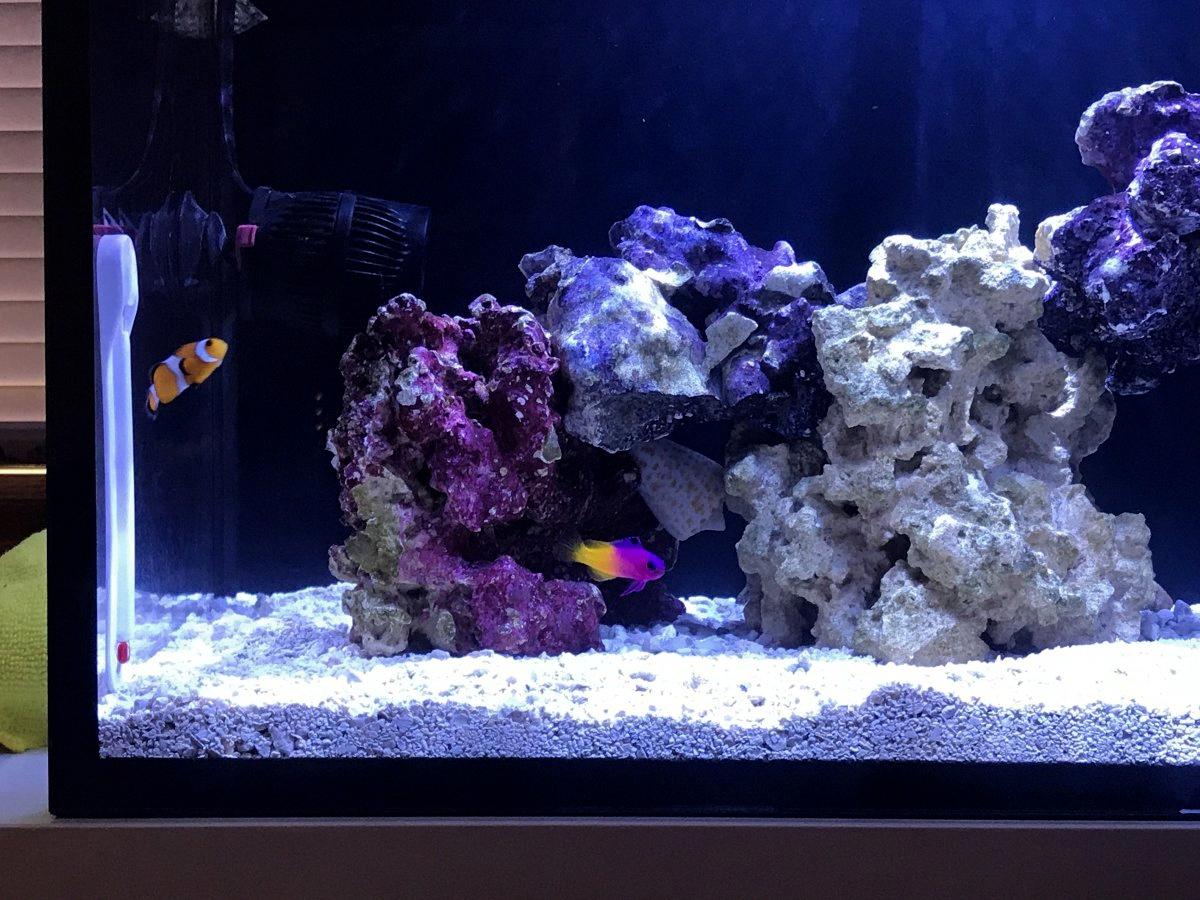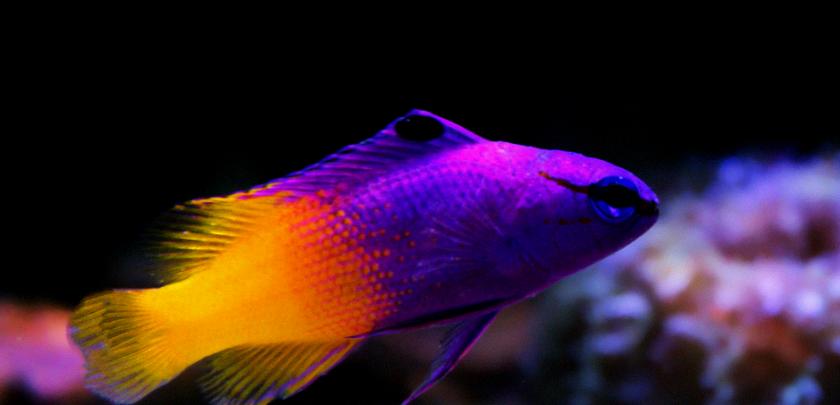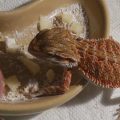If you’re looking for a peaceful, colorful fish to add to your saltwater tank then the Royal Gramma may be the perfect choice! This small, hardy fish is native to reefs in the Caribbean and can add a pop of color and activity to any tank.
The Royal Gramma has a distinct yellow body with a purple head and tail. These vibrant colors make them an attractive addition to any aquarium. They are peaceful fish that do well in reef tanks and will not harm other inhabitants such as corals, clams, or invertebrates.
In terms of care, the Royal Gramma is quite easy to look after. They are hardy fish that can adapt well to changes in the water parameters of teir environment. However, they should not be exposed to strong lighting as they prefer deep-water reefs in their natural habitat. The Royal Gramma is also known for its tendency to jump so it’s important that you make sure your tank has a secure lid!
Feeding your Royal Gramma is quite simple. They are omnivores so they will happily eat both meaty foods like frozen brine shrimp and algae-based foods like spirulina flakes. It’s important to feed them several small meals throughout the day rather than one large meal as this will help keep their energy up and prevent them from becoming overweight or unhealthy.
Breeding your own Royal Grammas can also be quite straightforward if you have the right conditions set up in your tank. These fish prefer dim lighting and plenty of hiding places such as caves or rocks for cover when spawning. The male will court the female by displaying his vibrant colors before she lays her eggs on a flat surface such as coral or rockwork. Once fertilized, these eggs will hatch within 24 hours so it’s important to remove any other fish from the tank before this happens!
Overall, the Royal Gramma is an excellent beginner-friendly species that can bring life and color into any saltwater tank! Thanks to their peaceful nature and easy care requirements, these fish make great additions even for novice aquarists who are just getting started with setting up their first tank.
Is a Royal Gramma Fish Suitable for a Reef Aquarium?
Yes, a royal gramma is entirely reef-safe. This small, vibrantly colored fish is a peaceful addition to any saltwater aquarium and will not bother other inhabitants. While they may pick at some kinds of algae, they shold leave all corals, clams, and other invertebrates unharmed. When it comes to feeding, royal grammas are omnivorous and usually accept almost any kind of food offered. However, like most fish in the ocean, they prefer a varied diet that includes some plant matter. Providing them with plenty of live rock for grazing and frozen or flake foods will keep them healthy and beautiful.

Source: reef2reef.com
Keeping Royal Gramma Fish in an Aquarium
Yes, royal gramma are very easy to keep, making them a great choice for novice aquarists. They are hardy and peaceful, meaning they can tolerate a wide range of water conditions and won’t cause any issues with tankmates. They also require minimal maintenance, requiring only regular water changes, quality filtration systems, and some additional supplements such as calcium to maintain their health.
Do Royal Grammas Have the Ability to Jump?
Yes, royal grammas are known to jump out of thir tanks. They are a species of fish native to deep water reefs and thus they can become startled by bright or hard lighting, which can make them more likely to jump. To avoid this, it’s important to keep them in a tank with a well-fitted lid and provide plenty of hiding spots and shadows with low lighting.
Is a Royal Gramma a Good Starter Fish?
Yes, a royal gramma is an excellent choice for a starter fish. They are highly adaptable and hardy, making them very easy to care for. They have a mild temperament whch makes them suitable for community tanks, and they can thrive in a variety of water parameters. Royal grammas are also omnivorous and enjoy eating flakes, pellets, frozen foods, and live food such as brine shrimp or mysis shrimp. In addition, they are one of the easiest fish to breed in the aquarium hobby due to their small size and prolific spawning habits. All these factors make the royal gramma an ideal choice for any beginner aquarist.
Do Royal Gramma Fish Swim Upside Down?
Yes, royal grammas are known to swim upside down and sideways in captivity. This is a natural behavior for them, as they typically hug rocky surfaces in the wild. It is important to note that this behavior is normal, so there’s no need to be alarmed if you see your royal gramma swimming upside down.
Maximum Size of Royal Grammas
Royal grammas are small fish, averaging slightly over 8 cm (3 inches) in length. The largest recorded specimen was measured at 8 cm (3.1 inches). These fish have been successfully bred in captivity, so size may vary depending on the environment they are kept in. Generally speaking, however, royal grammas rarely exceed 8 cm (3 inches).
The Peacefulness of Royal Gramma Fish
Yes, the Royal Gramma is a peaceful fish and an ideal inhabitant for many saltwater aquariums. This Basslet is not known for being aggressive with other tankmates, and it will mostly mind its own business. It is important to note that Royal Grammas may become territorial towards similar-looking species or when placed in an overcrowded aquarium. Therefore, it is recommended to provide plenty of hiding places and make sure there are no aggressive species living in the same tank. In general, this fish has a calm disposition and can peacefully coexist with other marine life.
Do Royal Gramma Fish Exhibit Hiding Behavior?
Yes, royal gramma fish do tend to hide a lot when first introduced to their new tank. As they become more comfortable with their environment, they will be more likely to come out and explore. To encourage your royal gramma fish to come out of hiding, make sure the water conditions are ideal and that there is plenty of rockwork and other hiding places in the tank.
Susceptibility of Royal Grammas to Ich
Yes, royal grammas are unfortunately quite susceptible to Ich, also known as White Spot Disease. This disease is caused by a parasitic protozoan and is one of the most common aquarium diseases. Symptoms include white spots on the fish’s body, fins, and gills, as well as loss of appetite and changes in behavior. If left untreated, Ich can cause serios illness or even death in royal grammas and other fish species. To avoid an outbreak of Ich in your aquarium it is important to keep the water parameters within healthy levels and to quarantine any new additions for at least two weeks before introducing them into your tank.

Source: fantaseaaquariums.com
Captive Breeding of Royal Gramma Fish
Yes, Royal Gramma are captive bred and they have been successfully bred in captivity sice the 1990s. Captive breeding has allowed hobbyists to breed these fish in their own home aquariums and make them available for purchase. Captive bred Royal Gramma are generally healthier and better adapted to life in a home aquarium than wild caught specimens.
Feeding a Royal Gramma Basslet
A Royal Gramma Basslet should be fed a varied diet of meaty fare, including brine shrimp, mysis shrimp, and quality frozen preparations. For the best nutrition, feed small amounts several times per day. It is important to remember that Royal Grammas are carnivores and need a diet rich in protein. Frozen foods such as bloodworms, krill, silversides and chopped seafood should also be included in their diet. Supplementing with vitamin-enriched flakes or pellets is also recommended.
Do Royal Gramma Fish Consume Copepods?
Yes, Royal Gramma are known to eat copepods. They are omnivorous and consume a variety of foods in the wild, including small crustaceans like copepods. In captivity, they can be fed a variety of prepared frozen or live foods such as lobster eggs, newly hatched brine shrimp and copepods. These should be supplemented with other non-living food sources such as flakes or pellets to ensure adequate nutrition. If you have plenty of copepods in your tank then the Royal Gramma is likely to feed on them as well.
Keeping Multiple Royal Gramma in an Aquarium
Yes, you can have multiple royal gramma in the same tank. To ensure a healthy environment for your fish it is best to provide them with a 55-gallon or larger tank so they have enough space to swim and establish territories. When adding multiple royal gramma, it is important to add them at the same time and monitor the tank closely for any signs of aggression. If aggression does occur, try rearranging decorations to break up territorial lines or add more hiding places for the fish. Additionally, providing pleny of food and maintaining good water quality can help reduce aggression between fish.
Nocturnal Habits of Royal Gramma Fish
Yes, royal gramma fish are nocturnal. During the day, they can be found in lagoons or along outer reef slopes at depths of up to 30 meters (98 feet). At night, however, they can be found up to 100 meters (~328 feet) deep. They feed on plankton, zooplankton, algae, or benthic invertebrates such as crustaceans and mollusks during this time.
Conclusion
In conclusion, the Royal Gramma is an ideal choice for any novice aquarist looking to add some color and personality to their tank. These hardy fish are easy to care for, feed and breed, and they are also reef-safe – meaning they won’t cause harm to other inhabitants of the tank. With their peaceful temperament and ability to tolerate less than perfect water conditions, the Royal Gramma is a great choice for anyone looking for a colorful and unique addition to their saltwater aquarium.












